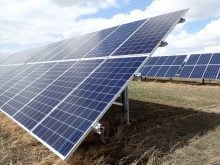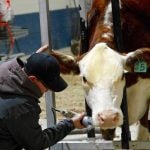Tractors, combines and high clearance sprayers may be powered by electricity in the foreseeable future.
Now, before you conjure up images of a massive golf cart pulling an air drill, let me hasten to explain that this refers to diesel-powered electricity.
Agritechnica, the largest farm equipment show in the world, recently wrapped up in Hanover, Germany. Many other farm innovations captured the limelight.
The gold award winning innovation was Fendt’s Guide Connect. The concept is simple: two outfits working in the field with only one operator. It is a bit eerie seeing the video – how the second tractor and implement follows the lead tractor and implement without a person in the second tractor cab.
Read Also

Farmer ownership cannot be seen as a guarantee for success
It’s a powerful movement when people band together to form co-ops and credit unions, but member ownership is no guarantee of success.
Fendt officials say their plan is to have the first commercial system running by late 2012. Germany will see the first commercial release and the system will start out in the largest Fendt tractors.
With the technology already available, this new development isn’t a big surprise. It’s an intermediate step to the remote control that’s long been touted and removes many of the safety and liability issues that arise when you try to operate machines without direct human supervision.
Another Agritechnica display that caught my eye, although it didn’t win any innovation awards, was from Lykketronic of Denmark. It’s promoting web-based monitor and control systems for sprayers and other equipment.
You can walk around the sprayer checking nozzles by turning them on and off with your smart phone. If you have a problem, a service technician can diagnose it by logging onto the control panel of your machine through the web. If you want to see a training video on an aspect of your sprayer, you can pull it up right away.
All you need is a standard smart phone. You don’t need an app, just a web browser. You’re using technology already developed.
The electronics world likes to talk about isobus, whereby the electronics of the various makes and models of equipment have a common communications format. If this approach from Lykketronic catches on, perhaps isobus would become less important. The company isn’t selling to producers. It wants to catch the eye of equipment manufacturers.
Getting back to diesel-electric, it was really only presented on one medium-sized Fendt tractor, where a front power take-off connected to an electrical generator. Cables from the generator carried the power to large electric motors running a rotor tiller at the back of the machine.
As Wolfgang Hager of Sensor-Technik in Germany explained, this retrofitted tractor is not the future. To be viable, the electrical generator needs to be built into the diesel engine. In that configuration, electric power becomes efficient.
Hydraulic power loses a lot of its efficiency as oil is pumped through hoses and motors. Even the mechanical linkage used through a transmission to turn drive wheels has efficiency losses. Sensor-Technik envisions a time when all of a tractor or combine’s functions will be electric.
More efficient power generation means less diesel fuel. And of course, electric power can be easily fine-tuned to meet exacting needs. It’s a flexible power source.
How quickly might all of this happen?
Hager claims the entire farm equipment industry is working on the concept. Part of that is designing standards, such as which voltage to use.
He is promising major developments on display at the next Agritechnica in 2013 and he predicts commercially available equipment in the next six or eight years.
Kevin Hursh is an agricultural journalist, consultant and farmer. He can be reached by e-mail at kevin@hursh.ca.















